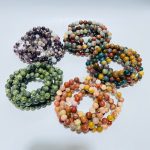Are you the lucky owner of a backyard brimming with natural wonders? If so, you may be in for a delightful surprise: the potential presence of quartz, an enchanting mineral that can transform your outdoor space into a glittering paradise.

What is Quartz?
Quartz, one of the most abundant minerals on Earth, is a crystalline form of silicon dioxide (SiO2). It comes in a dazzling array of colors, including clear, white, pink, purple, green, and yellow. Its exceptional durability makes it resistant to weathering and erosion, ensuring its presence in backyards for years to come.
Identifying Quartz in Your Yard
Physical Characteristics:
* Crystalline structure, with visible facets and edges
* Glassy luster that reflects light
* Hardness of 7 on the Mohs scale, making it scratch resistant
* Transparent to translucent appearance
Common Forms:
* Crystals: These pointed or multifaceted formations can range in size from tiny grains to large boulders.
* Quartz veins: Narrow bands of quartz that cut through other rocks.
* Geodes: Hollow rocks lined with quartz crystals.
Tips for Finding Quartz in Your Yard
- Examine rocky areas: Quartz is commonly found in association with rocks such as granite, gneiss, and sandstone.
- Look for glittering surfaces: The glassy luster of quartz reflects light, creating a sparkle or shimmer.
- Check soil samples: Crumbled quartz may be present in the topsoil or subsoil.
- Consider professional help: If you’re having difficulty identifying quartz, consult a geologist or mineralogist for assistance.
Common Mistakes to Avoid
- Confusing quartz with other minerals: Other minerals, such as calcite and feldspar, can resemble quartz. Use the physical characteristics above to distinguish them.
- Overlooking small crystals: Even tiny quartz crystals can add a touch of sparkle to your yard. Don’t ignore them when searching.
- Damaging the environment: Avoid using heavy machinery or digging large holes when searching for quartz. Respect the natural ecosystem.
FAQs
- Can I use quartz for landscaping? Yes, quartz gravel and crushed quartz are popular decorative materials for pathways, borders, and rockeries.
- Is quartz safe to handle? Yes, quartz is inert and non-toxic. It poses no health risks when handled properly.
- Can I sell quartz I find in my yard? You may be able to sell larger, high-quality quartz crystals to collectors or jewelers. Consult a local mineral dealer for more information.
Creative Applications for Quartz in the Yard
SparklePath: Create a twinkling walkway by lining it with quartz gravel or crushed quartz. The shimmering pathway will guide you through your yard at night.
QuartzZen: Design a calming meditation area filled with quartz crystals. The energy of quartz is believed to promote relaxation and focus.
GeodeGarden: Plant succulents or wildflowers inside halved geodes. The vibrant colors of the quartz crystals will complement the greenery, creating a unique and enchanting garden element.
Quartz Statistics
- Quartz is the second most abundant mineral in the Earth’s crust.
- According to the U.S. Geological Survey, the United States produces approximately 11 million tons of quartz annually.
- Quartz is used in a wide range of industries, including construction, electronics, and pharmaceuticals.
- The value of quartz can vary greatly depending on its size, quality, and color.
Tables
Table 1: Physical Properties of Quartz
| Property | Value |
|---|---|
| Chemical composition | SiO2 (silicon dioxide) |
| Crystal structure | Hexagonal |
| Hardness | 7 on the Mohs scale |
| Density | 2.65 g/cm³ |
| Refractive index | 1.54-1.55 |
Table 2: Colors of Quartz
| Color | Cause |
|---|---|
| Clear | No impurities |
| White | Milky inclusions |
| Pink | Iron impurities |
| Purple | Manganese impurities |
| Green | Chromium impurities |
| Yellow | Iron and aluminum impurities |
Table 3: Common Forms of Quartz
| Form | Description |
|---|---|
| Crystals | Pointed or multifaceted formations |
| Quartz veins | Narrow bands of quartz in other rocks |
| Geodes | Hollow rocks lined with quartz crystals |
| Gravel | Small, rounded quartz fragments |
| Crushed quartz | Processed quartz fragments used as a decorative material |
Table 4: Uses of Quartz
| Industry | Application |
|---|---|
| Construction | Building materials, countertops |
| Electronics | Computer chips, solar panels |
| Pharmaceuticals | Drug manufacturing, glass containers |
| Jewelry | Gemstones, ornamental items |
| Landscaping | Decorative gravel, rockeries |




























